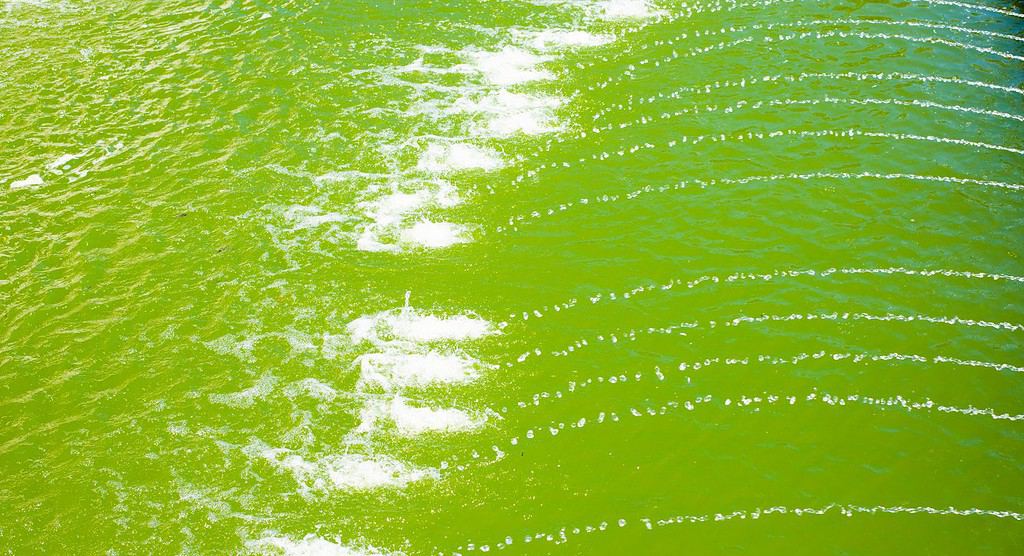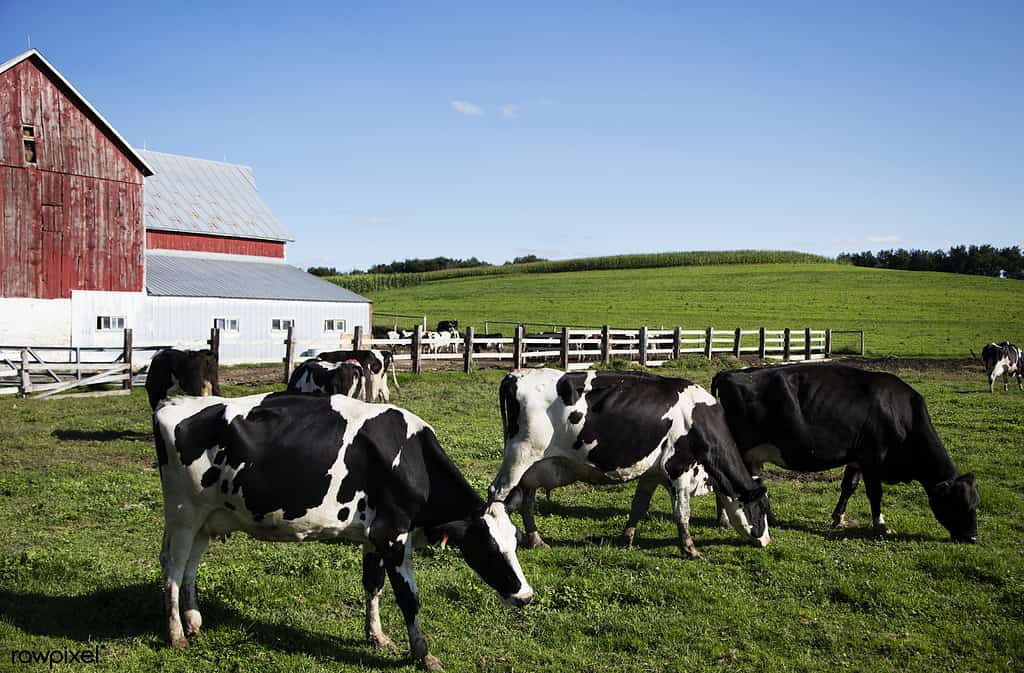
A green tide is visible from space if it gets large enough.
©krovsmolokom13/Shutterstock.com
There has been a huge increase in the number of algal blooms throughout the world in the last few decades. While some of them don’t do much more than disrupt tourism, many of them have the potential to be harmful to people, animals, and the environment. One such bloom that’s been increasing since the 1970s is the green tide.
Brown, gold, red, and green tides are all forms of algal blooms. Green tides are found throughout the world but are most common in China and France. To learn more about green tides, how they happen, and their dangers, keep reading below.
What Is Green Tide?

Green tides get their name from the color they turn the ocean water.
©SERASOOT/Shutterstock.com
Green tide is a form of algal bloom. It occurs when macroalga starts to produce and grow quickly. Unlike some other tides, such as red tide, green algae is caused by plankton, also known as macroalgae. This means that the cause of this tide is actually a seaweed or seagrass.
There are a few different species that cause green tides, almost all of them a part of the Ulva genus. One of the most notable is Ulva prolifera. This is a macroalgae commonly referred to as sea lettuce. This sea lettuce is what caused a green tide in the western Yellow Sea during the sailing games of the Olympics in China in 2008.
It was a rather large bloom that happened in a very short amount of time. It ended up covering one percent of the surface of the Yellow Sea near Qingdao. Though this algal bloom wasn’t toxic, the large clumps of green sea lettuce that sat on the water meant possibly stopping the sailing competition.
Because many people were tuning in to watch the Olympic games, the news of the algal bloom spread. It gained enough attention that scientists started to study U. prolifera. They found that an algal bloom from the same plant was often found offshore of the Jiangsu province.
With Qingdao and the northernmost part of the Jiangsu province being roughly 151 miles from each other, scientists realized that algal blooms could travel some great distances.
Have Green Tides Always Been Around?
Green tides are a natural part of the ocean’s cycle. Sometimes, algae will bloom at a much higher rate than normal, and take over an area of the ocean. However, it was common for it to happen every decade or so.
Since the 1970s, green tides started to grow more abundant, happening every few years, or even multiple times throughout the year. Problems started to grow worse with each algal bloom as well.
They are growing more toxic (and toxic more often) and are growing big enough to cause dead zones in the ocean. These dead zones are areas where the water doesn’t have any oxygen and is unable to support life. Sometimes, these dead zones are permanent, and sometimes only temporary.
What Causes Green Tide?

Farming is the major producer of nutrients that cause algal blooms.
©Rawpixel Ltd / CC BY 2.0 – License
An excess of nutrients is what causes a green tide. Most algal blooms come from an excess of two nutrients in particular; nitrogen and phosphorous. These nutrients are commonly caused by farm runoff. Fertilizers and animal waste have a lot of nitrogen and phosphorous in them. During heavy rains, these nutrients run into the water and eventually make their way into the ocean.
Warm ocean temperatures can also help to create algal blooms, as algae grow best in warm conditions. In cooler areas of the ocean, algal blooms are slower to form or may be halted altogether even in the presence of a lot of nutrients.
For the Yellow Sea algal bloom above, the cause for it was rather unique. The Jiangsu province has algae farms for the edible red algae, Porphyra yezoensis. However, since U. prolifera blooms under the same conditions, it has a habit of forming on the farms as well.
Since the farmers only wanted the red algae, they discarded the green algae. Unfortunately, they do this by releasing it back into the ocean. Over time, the green algae then starts to meet up and turn into blooms. Ideal ocean conditions and high levels of nutrients, commonly found in the Yellow Sea, further exasperate the problem, allowing the algae to proliferate much faster.
Where Are Green Tides Found?
Green tides are found all over the world. They tend to prefer temperate coasts, and this is where they are found the most. Green tides may also be found around sheltered environments and transitional water such as estuaries, closed seas, and mud flats. The two areas where green tides are noticed commonly are in China, in the Yellow Sea, and in France, along Brittany and Normandy.
Though this species of algae is found in most temperate conditions, they are starting to spread out and bloom in new areas than they had previously as the ocean increases temperature. The rate at which green tides happen is also increasing. Some areas like the Yellow Sea find green tides to now be a frequent occurrence.
Is Green Tide Dangerous?

Hydrogen sulfide is one of the major dangers that comes with green tides.
©Vitalii Vodolazskyi/Shutterstock.com
Green tides aren’t toxic. Ulva prolifera is a fairly common form of sea lettuce, which doesn’t have any toxic properties. Most macroalgal blooms aren’t toxic, it’s microalgal blooms that are the problem. However, that doesn’t mean that the green tides are entirely safe. They may be fine while they are blooming. It’s when they are starting to die off that problems occur.
There’s still a lot to learn about green tides. It wasn’t until 1980 that people even realized that these algal blooms could be dangerous. Several seemingly random deaths occurred after people and animals were on or around beaches with these algal blooms before someone thought to put it together.
Most of the issue comes from the rotting algae. As it starts to break down, it releases hydrogen sulfide gas. The gas is colorless but has a strong smell comparable to rotten eggs. It’s flammable and highly toxic. It can poison anyone who inhales it. The poison then causes damage to the eyes, lungs, and skin because of its corrosive properties.
Other Dangers of Green Tide
Even if green tides aren’t directly toxic, they aren’t harmless. An algal bloom has the potential to disrupt the local economy. Algal blooms also cause a lot of damage to local wildlife, especially the plants and animals that can’t move to avoid them.
Not many people are comfortable going to the beach when there is a green tide, even if the bloom isn’t toxic. This means that during blooms, tourism takes a huge hit.
Algal blooms eventually wash up on the beach. They can leave horrible smells and cause deterioration of the shoreline. Quick cleanup after an algal bloom is needed to bring tourists back and keep the beach healthy.
In Brittany, France, in 2008, the coasts were lined with over 100,000 tons of beached algae. The removal cost well over a million dollars with each ton costing somewhere between $100 and $150 to remove.
Additionally, bivalves often suffer the worst from algal blooms. Bivalves include animals that have a two-part shell to protect the invertebrates inside. Examples of bivalves are mussels, clams, and oysters.
These animals aren’t able to move away from algal blooms. During severe blooms, they suffer from a lack of oxygen. The algae may also be missing nutrients that bivalves need, but out-competing with other necessary food for these invertebrates, so they aren’t able to get enough good algae to survive.
The photo featured at the top of this post is © Tony Dunn/Shutterstock.com
Thank you for reading! Have some feedback for us? Contact the AZ Animals editorial team.






